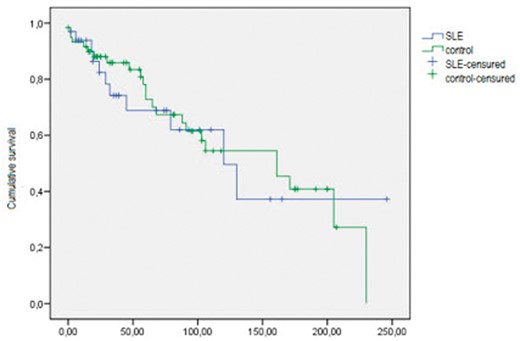-
PDF
- Split View
-
Views
-
Cite
Cite
Laura Fuentes Sánchez, Tamara Jimenez Salcedo, Patricia Garcia-Frias, Cristina Gutierrez de la Fuente, Mercedes Cabello Diaz, Veronica Lopez Jimenez, Pedro Ruiz Esteban, Domingo Hernandez Marrero, SP765
SURVIVAL OF LUPUS NEPHRITIS IN RENAL TRANSPLANTATION IN MÁLAGA, Nephrology Dialysis Transplantation, Volume 32, Issue suppl_3, May 2017, Page iii402, https://doi.org/10.1093/ndt/gfx157.SP765Close - Share Icon Share
INTRODUCTION AND AIMS:Background: Previous studies have shown that the survival of patients with lupus nephritis (LN) who are transplanted with respect to non-diabetic controls have superimposable results.Objective: The aims was to evaluated the survival of lupus patients transplanted in our center, and determine risk factors of mortality and graft loss.
METHODS: Study cohort, case-control (1:2) in patients with CKD secondary LN who received a kidney transplant (n = 32) in the Malaga area (between 1985 and 2010). The controls (n = 64) were matched by age, sex and period of transplant patients. We analyzed graft survival and patient, and risk factors compared with long-term transplant patients without LN.
RESULTS: The analyzed variables between groups were not different, only the most frequent cause of donor death was approached statistical significance: stroke in LN and head injury in controls (p = 0.05). 45% of the population lost the graft, primarily due to chronic kidney disease 53.5%, followed by vascular thrombosis 16.3% (p = 0.57). Censored graft losses occurred 63% in patients transplanted before 2000, whereas this occurred in 20% of which were made from 2000, p <0.000. Censored graft survival was superimposable between groups throughout the follow-up, as well as the survival of patients. About Cox regression, only acute rejection was associated with a twofold increased risk of graft loss.

SP765 Figure





Comments